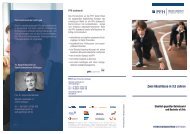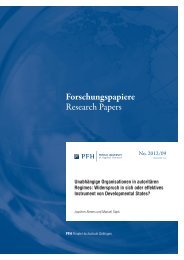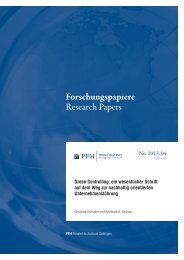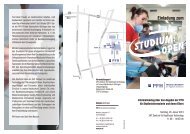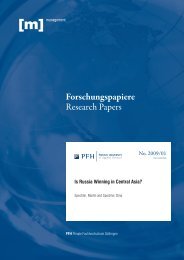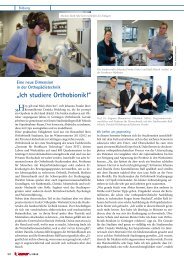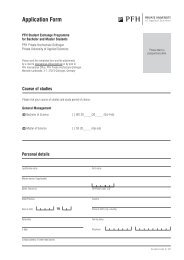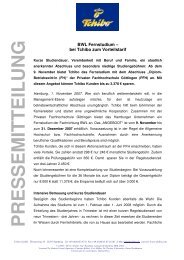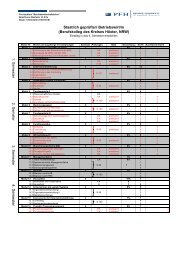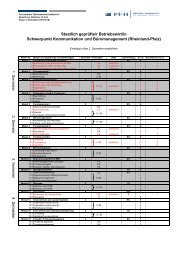View - PFH Private Hochschule Göttingen
View - PFH Private Hochschule Göttingen
View - PFH Private Hochschule Göttingen
Create successful ePaper yourself
Turn your PDF publications into a flip-book with our unique Google optimized e-Paper software.
The paper shows that natural resources and capital inflows exert an insignificant or<br />
negative influence and that economic policy allows to break path-dependency. At the same<br />
time, transition countries benefited from external incentives provided from both EU and<br />
NATO. Below a membership perspective, ENP and NATO-MAP provide trade and security<br />
incentives respectively. This allows to assess the situation of the Central Asian countries in<br />
contrast to comparable FSU countries which may benefit (more) from external incentives.<br />
Section 2 gives a short overview of the existing literature which presents the theoretical<br />
arguments. Results from panel estimations for 25 transition countries for the period from 1996<br />
to 2005 based on the World Bank Governance Indicators, the most comprehensive measure<br />
for institutional quality publicly available, are shown in section 3. Section 4 summarizes and<br />
draws policy conclusions for Central Asian FSU countries.<br />
2. Empirical Evidence on External Drivers of Institutional Change<br />
A political economy explanation of why institution building has varied so much across<br />
transition countries which are resource rich like Kazakhastan and Turkmenistan, and, to a<br />
lesser extent, Uzbekistan is provided by Beck and Laeven (2006). They argue that political<br />
entrenchment and reliance on natural resources critically determine whether the behavior of<br />
the ruling elite and thus the transition process are catalytic or extractive. While this seems to<br />
support the pessimistic view that initial conditions determine future outcomes (Fish 1997;<br />
Kopstein and Reilly 2000; Guiso et al. 2006; Zweynert 2006), there is also a more optimistic<br />
view on the potential for institutional progress in rent-seeking societies which links<br />
economics and politics. Olson (2000) argues that the availability of short-term rents like nonrenewable<br />
resources provides the basis for the rent-seeking strategy of “roving bandits”, but<br />
that “roving bandits” could transform into “stationary bandits” after having reached the limits<br />
of their capacities to accumulate and control the wealth on the basis of informal institutions<br />
(see also Tornell 1998; Dixit, Grossman and Helpman 1997).<br />
Concerning the influence of resource endowment on institution building, plenty of studies<br />
suggest that the adverse effect of resource abundance on institutional quality is particularly<br />
strong for easily accessible ‘point-source’ natural resources with concentrated production and<br />
revenues and thus massive rents, i.e., oil, diamonds, minerals and plantation crops rather than<br />
agriculture (e.g., rice, wheat and animals) whose rents are more dispersed throughout the<br />
economy, and with easy appropriation of rents through state institutions (Auty, 1997, 2001;<br />
Isham, et. al., 2005; Sala-i-Martin and Subramanian 2003; Murshed, 2004; Collier and<br />
3



